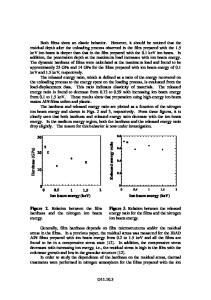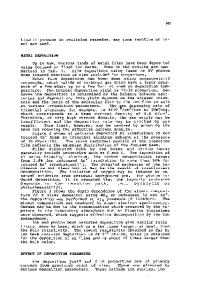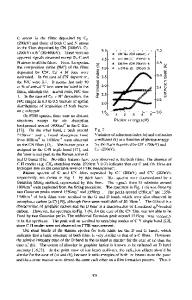1X Thin Films Prepared By Mass Separated Ion Beam Deposition
- PDF / 477,146 Bytes
- 6 Pages / 414.72 x 648 pts Page_size
- 53 Downloads / 448 Views
In this paper we report on the growth and properties of CxNl, films prepared by deposition 14 of mass separated 12 C' and N' ions. The influence of ion energy, C:N ion ratio and substrate temperature on film properties like stoichiometry, density and thickness, electrical properties and chemical bonding was studied for ions deposited at energies in the range 20 eV to 500 eV and for substrate temperatures of 20 "C and 350 "C. The electrical properties were compared to N-doped diamond like carbon films which were also prepared by mass separated ion beam deposition. FILM PREPARATION Carbon nitride thin films were grown on single crystalline Si and polished stainless steel 14 12 substrates by direct deposition of low energy C' and N+ ions. We have used a 30 keV mass the ions down to energies bedecelerate to system lens separated ion beam and an electrostatic tween 20 eV and 500 eV before deposition. The lens system and the heatable substrate were mounted in a differentially pumped deposition chamber allowing a pressure below 10" Pa during deposition. The films are therefore expected to be free of contaminants like oxygen or hy[19]. Typical current drogen. The details of the UHV-deposition system are described elsewhere 2 densities for deposition energies above 50 eV are about 30 pA/cm , and about 215 tA/cm' for deposition energies of 20 eV. A uniform deposition over an area of about 1.8 cm was achieved using a beam sweep in front of the deceleration stage. The film composition was controlled by was used to measuring the ion charge deposited onto the substrate. The charge measurement 4 2 alternatingly switch the separation magnet between masses 1 C and 1 N, so that a constant 2 C': N' ion ratio was achieved. During each switching cycle typically 1.1015 ions/cm were deposited ensuring a homogenous film composition. The substrates were cleaned in-situ immediately before deposition by sputtering with 601 1 keV 4 °Ar+ ions. In this way we have grown -----------,-carbon nitride films on substrates kept at room C4 N . 50. temperature or heated to 350 "C. For the dif. ofCN ferent samples the C': N' ion ratio was 40 • varied from 1 0, i.e. pure carbon, up to 1 3. 0
o
30.
Z : 20 4) 5 10. Cd 0 0
Figure 1: Measured N concentration of CN films deposited onto12 Si at room 14 temperature using 100 eV C' and N+ ions as a function of the N+ ion fraction. For an N+ ion fraction above 0.7 no CN film growth and only the formation of thin silicon nitride layers was observed.
00
'
0.2 0.4 0.6 0.8 14N+ ion fraction
j 1.0
RESULTS AND DISCUSSION The nitrogen content of the films was analyzed by Rutherford backscattering spectroscopy 2 4 (RBS) using 700 keV He + or 350 keV H÷ and Auger electron spectroscopy (AES). In addition, some films with low N content were analyzed using neutron depth profiling [22]. The thickness of the films was measured using a profilometer. Together with RBS measurements we were able to determine the density of CN films grown under various conditions.
94
The efficiency of N incorporation was determined fro
Data Loading...










